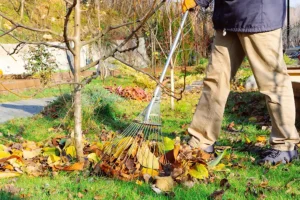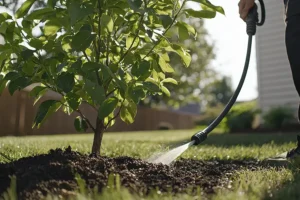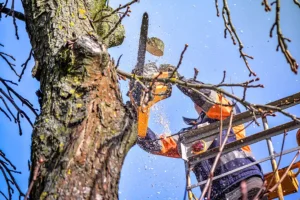Proper tree pruning is essential for maintaining the health, appearance, and safety of your trees. However, many homeowners make common mistakes that can harm their trees and compromise their well-being. At Madcow Outdoor Service in Alton, IL, we understand the importance of proper tree care practices. In this blog post, we’ll discuss seven tree pruning do’s and don’ts to help you avoid common mistakes and ensure the health and longevity of your trees.
Don’t: Prune Too Much / Do: Follow the One-Third Rule
Don’t: It can be tempting to remove large branches or prune extensively to achieve the desired shape or size of a tree. However, excessive pruning can stress the tree and weaken its structure, making it more susceptible to disease and insect infestations.
Do: Instead of removing large portions of the tree at once, adhere to the one-third rule, which recommends removing no more than one-third of the tree’s canopy in a single pruning session. This allows the tree to recover more quickly and reduces the risk of stress-related issues.
Don’t: Neglect Proper Pruning Techniques / Do: Use Correct Pruning Methods
Don’t: Improper pruning techniques, such as topping or lion tailing, can result in long-term damage to the tree and compromise its health and stability. Topping involves cutting the main trunk or branches indiscriminately, while lion’s tailing involves removing inner foliage and branches, leaving only foliage at the ends.
Do: Instead of topping or lion tailing, use proper pruning techniques such as selective branch removal, crown thinning, and directional pruning. These methods promote healthy growth and maintain the tree’s natural shape and structure.
Don’t: Prune During the Wrong Season / Do: Prune During the Dormant Season
Don’t: Pruning at the wrong time of year can stress the tree and interfere with its natural growth cycle. For example, pruning during the dormant season can stimulate new growth that is vulnerable to frost damage, while pruning during the growing season can disrupt the tree’s ability to photosynthesize and recover from wounds.
Do: The best time to prune most trees is during the dormant season, typically late fall to early spring, when the tree is not actively growing. Pruning during this time minimizes stress on the tree and promotes faster healing of pruning wounds.
Don’t: Leave Wounds Unprotected / Do: Apply Wound Dressing
Don’t: Leaving pruning wounds exposed to the elements can increase the risk of disease and decay. Insects, fungi, and bacteria can enter the tree through open wounds, causing further damage and compromising its health.
Do: After pruning, apply a protective wound dressing or pruning sealant to the cut surfaces to prevent moisture loss and reduce the risk of infection. Be sure to use a product specifically designed for tree wounds and follow the manufacturer’s instructions for application.
Don’t: Ignore Structural Pruning / Do: Perform Structural Pruning
Don’t: Neglecting to address structural issues such as co-dominant leaders, weak crotches, and crossing branches can lead to structural failure and pose a safety hazard. Weakly attached branches are more prone to breaking during storms or high winds, endangering property and people below.
Do: Regularly inspect your trees for structural issues and address them through proper pruning techniques. Remove competing leaders, correct narrow crotches, and eliminate crossing or rubbing branches to promote a strong and stable tree structure.
Don’t: Overlook Professional Expertise / Do: Hire A Professional Arborist
Don’t: Attempting to prune large or mature trees without the necessary knowledge, skills, and equipment can be dangerous and result in costly mistakes. Improper pruning techniques can damage the tree, injure yourself or others, and create liability issues.
Do: For complex pruning tasks or trees with significant structural issues, it’s best to hire a professional arborist with experience and expertise in tree care. A certified arborist can assess the health and condition of your trees, recommend appropriate pruning techniques, and safely perform the necessary work to ensure the health and safety of your trees. To hire the best local professional for your tree’s pruning needs, contact Madcow Outdoor Service today!
Don’t: Forget Regular Maintenance / Do: Schedule Regular Tree Inspections and Maintenance
Don’t: Ignoring routine tree maintenance can escalate problems and make them more challenging and costly to address. Regular pruning and maintenance help keep trees healthy, promote optimal growth, and reduce the risk of structural failure and disease.
Do: Make tree care a priority by scheduling regular inspections and maintenance with a professional tree care company. A trained arborist can assess the health and condition of your trees, identify potential issues, and implement proactive measures to keep your trees thriving for years to come.
Contact Madcow Outdoor Service for Expert Tree Pruning
Proper tree pruning is essential for maintaining the health, appearance, and safety of your trees. By following these tree pruning do’s and don’ts and enlisting the help of a professional arborist from Madcow Outdoor Service in Alton, IL, you can ensure the longevity and vitality of your trees. Call 618.288.9663 for superior tree pruning services, and let us help you keep your trees healthy and beautiful all year round.







